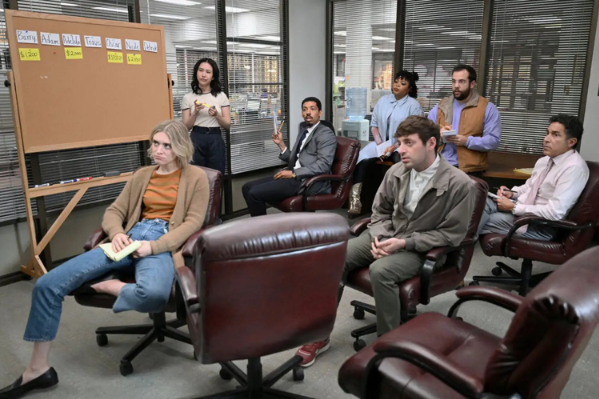1. A Grim Front Page: Comedy Meets Media Meltdown
The premise of The Paper begins with a paradox: how can comedy thrive when the subject is the collapse of an industry once seen as the lifeblood of democracy? Newspapers, once bastions of truth and accountability, are now relics, their printing presses wheezing as digital media consumes the landscape. To satirize this decline may seem grim, but the tradition of comedy has always been to confront discomfort head-on. Death, war, and racism have all been turned into biting satire—so why not the death of print?
This series embraces the sadness inherent in its premise but turns it into fertile ground for humor. The Toledo Truth Teller, the fictional paper at the heart of the show, embodies this crisis. It is both a stage for satire and a mirror for the anxieties of modern viewers. Through its struggles, The Paper confronts capitalism’s chokehold on media, the absurdity of corporate priorities, and the resilience—or foolishness—of those determined to keep journalism alive.
By balancing melancholy with humor, the show speaks directly to a generation grappling with both nostalgia and disillusionment. The laughs sting because they’re rooted in truth, making The Paper more than escapist entertainment—it’s a commentary on our times.

2. A Familiar Yet Fresh Setting: Truth Teller Tower Unfolds
The series is set in the once-proud offices of the Toledo Truth Teller, which now shares space with a toilet paper manufacturer. The symbolism is too sharp to ignore: truth, squeezed into a corner, literally overshadowed by consumer convenience. The absurdity of this arrangement becomes the show’s comedic bedrock, a daily reminder that journalism is now treated as a side business rather than a public service.
Carrying forward the mockumentary style perfected in The Office, the show roots itself in recognizable rhythms: the direct-to-camera interviews, the awkward silences, the raw workplace dynamics. Yet the new context feels distinctive. Instead of paper as a medium for truth, here paper is a commercial product, rolled and packaged, while truth struggles to remain relevant.
This setting is not just background—it’s character. Every cramped corridor, every misfitting desk shoved against industrial machinery, amplifies the show’s satire. By placing noble ideals in ridiculous circumstances, The Paper highlights the absurd compromises journalism must now make just to survive.
3. Characters in the Byline: Quirks, Clashes, and Charm
What makes The Paper compelling isn’t just the premise—it’s the ensemble that brings it to life. Domhnall Gleeson’s Ned Sampson is at the center: bright-eyed, passionate, but bumbling, he’s a man with big ideas and questionable execution. Ned’s character embodies the push-and-pull between idealism and incompetence, an editor who wants to save journalism but often sabotages himself.
Opposite him is Esmeralda Grand, the former editor whose role oscillates between saboteur and reluctant ally. Their relationship provides tension and humor, a constant dance between cynicism and naïve determination. Around them orbit an eclectic mix of personalities: Mare, the Army veteran-turned-writer, whose no-nonsense pragmatism cuts through the chaos; Barry, the sportswriter whose disillusionment is played for laughs but also paints a poignant picture of burnout; and an assortment of well-meaning misfits roped in from nearby businesses, who bring a delightful absurdity to newsroom operations.
This diverse group mirrors the heart of any good workplace comedy: contradictions, quirks, and unlikely friendships. Where The Office thrived on the awkward family dynamics of its employees, The Paper taps into the chaotic survival of a newsroom community—one where the stakes are high, but the incompetence is often higher.
4. Between Parody and Promise: Criticisms and Strengths
Early reviews of The Paper suggest a rocky start. Critics note that Ned’s character sometimes swings too wildly between competent leader and buffoon, leaving his comedic identity unclear. This tonal inconsistency can feel disjointed, especially when the show seems unsure whether to portray him as Michael Scott 2.0 or a more grounded everyman.
Additionally, while cameos from beloved characters in The Office offer nostalgic appeal, they occasionally feel shoehorned rather than essential. This tension raises a crucial question: is the show leaning too heavily on its predecessor’s shadow, or is it carving out an identity of its own?
Despite these challenges, the series gradually finds its rhythm. The ensemble deepens, jokes land more cleanly, and the satire sharpens as the season progresses. When the focus shifts from quirky office banter to the actual absurdities of reporting and publishing, the show truly shines. By the midpoint of the season, critics and fans alike note the humor becomes more confident and the emotional core more resonant.
This evolution highlights a central truth about spinoffs: they often stumble at first, but growth can transform them into something fresh and meaningful. The Paper may not yet match the iconic status of The Office, but it holds promise as a worthy heir with its own story to tell.
5. Continuing the Story: Why The Paper Matters Now
Beyond its comedy, The Paper resonates because of its cultural timing. Journalism today is under siege—from budget cuts to political pressures to the dominance of clickbait—and the show’s satire captures that reality. By transforming these issues into humor, it provides viewers with both catharsis and critique.
The decision to release all ten episodes at once reflects the binge-friendly habits of modern audiences, ensuring viewers can immerse themselves fully in the world of the Truth Teller. Even more telling is the network’s decision to renew the show for a second season before its premiere. That confidence suggests that the series isn’t just a nostalgic cash-in but a long-term investment in storytelling that matters.
More importantly, The Paper has the potential to shape public conversations about the media itself. Comedy has always been a powerful vehicle for truth, and by lampooning the decline of print journalism, the show underscores why journalism still matters. It reminds us that while newspapers may be fading, the pursuit of truth is worth laughing about—and worth fighting for.
Conclusion: From Ink to LOLs—The Paper’s Promise
The Paper stands at the crossroads of nostalgia and innovation. By borrowing the stylistic DNA of The Office while tackling the very real struggles of modern journalism, it straddles humor and heartbreak with surprising effectiveness. Its ensemble, its satirical setting, and its thematic depth make it more than just another spinoff.
Though imperfect in its early execution, the series has room to grow—and with more seasons ahead, it just might become the next workplace comedy that viewers return to again and again. After all, the best workplace comedies aren’t just funny—they’re cathartic, honest, and endlessly rewatchable.
The Paper may be about a dying industry, but as long as it keeps finding humor in the mess, it has a bright future.
From: Doublejoydesigns
